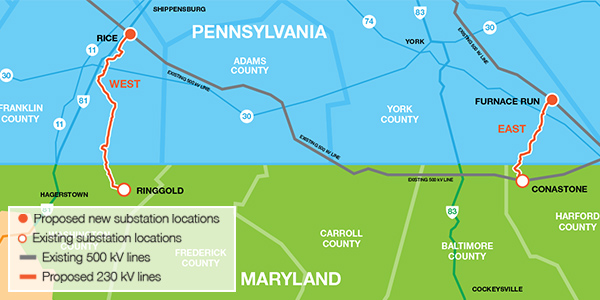By Christen Smith
Landowners united against a proposed transmission project straddling the Pennsylvania-Maryland border said on Monday they doubt an alternate plan using existing lines may cost an extra $94 million, as PJM suggests.
“I don’t see how that’s possible that by using existing infrastructure that it could be more expensive,” said Barron Shaw, spokesperson for Citizens to Stop Transource. “It’s hard to understand.”
Shaw’s group includes residents from Pennsylvania’s York and Franklin counties and Maryland’s Harford County, where Transource Energy plans to construct two 230-kV double-circuit lines totaling about 42 miles, known as the Independence Energy Connection (IEC) project. PJM selected the $372 million proposal — its largest market efficiency project to date — during the 2013/14 long-term planning window to address congestion in the AP South interface and has five times since reviewed its benefits to the grid, determining in each round that the IEC remains the most effective way to reduce load costs.
In testimony submitted to the Maryland Public Service Commission on May 8, PJM’s Tim Horger said the RTO’s most recent analysis, completed in February, determined the IEC would generate a $931 million reduction in congestion costs over the next 15 years, with a benefit-cost ratio of 2.17 — well above PJM’s 1.25 threshold required for inclusion in its Regional Transmission Expansion Plan.
Protesters argue, however, that the need for the eastern segment of the project could be met by the existing Furnace Run-Conastone and Furnace Run-Graceton 230-kV double-circuit transmission tower lines, which each have only one 230-kV circuit and could carry a second. Maryland’s Power Plant Research Program (PPRP) urged the PSC to suspend the project while PJM studied the market efficiency of this alternative and three others — a request that was granted in January. (See More Info Needed on Tx Line Options, MD PSC Says and Cancel Transource Line, Md. Panel Says.)
As requested, PJM analyzed PPRP’s four conceptual alternatives and determined all but its third option — adding lines to the Furnace Run-Conastone towers — created thermal violations too costly to even consider for its RTEP. Even still, to help the remaining plan survive its market efficiency process, PJM and Transource expanded the scope to add a third transformer at the Furnace Run station that would alleviate possible reliability violations. This modified plan was called 3A in PJM’s testimony.
Steve Herling, PJM’s vice president of transmission planning, said in testimony that the additional transformer caused the Peach Bottom-to-Furnace Run 500-kV lines to reach 98.5% of its thermal conductor limit following a single contingency. Conversely, the IEC takes significant power load off that line, Herling said, calling into question the viability of the proposed configuration in 3A.
PJM’s analysis showed 3A would cost between $54 million and $94 million more than IEC and produce $267 million less in congestion benefits to the region. Its benefit-cost ratio ranges from 1.39 to 1.52, still well above PJM’s 1.25 threshold but lagging far behind the IEC’s rating.
Herling said none of the conceptual alternatives proved “demonstrably superior” or even equal to the IEC plan. Jeff Shields, PJM spokesman, said Monday that staff stand by their testimony.
PSC hearings on the project begin in Maryland on June 3. Meanwhile, an administrative law judge in Pennsylvania will consider the IEC’s reliability benefits after the state Public Utility Commission overturned a prior dismissal of PJM testimony regarding the issue.
PPRP has described PJM’s attempt to justify the project on reliability grounds as a “bait and switch.” Although the project was not needed to address reliability violations when it was approved, the RTO said “that the project would inherently enhance system reliability by introducing additional transmission network paths.”
“Reliability means generator-deliverability reliability,” Shaw said. “It’s not about keeping people’s lights on.”




